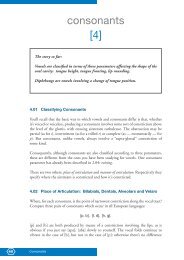PHONETICS MANUAL.indd - HumBox
PHONETICS MANUAL.indd - HumBox
PHONETICS MANUAL.indd - HumBox
Create successful ePaper yourself
Turn your PDF publications into a flip-book with our unique Google optimized e-Paper software.
[h] (read as “aitch” — it’s incorrect to call it “haitch”, whether you’re using the ordinary<br />
alphabet or the IPA!). This is for the first consonant of English or German hat. It’s<br />
classified as a voiceless glottal fricative: the vocal folds constrict the airflow, but aren’t<br />
close enough together to vibrate. Effectively [h] is a whispered version of the (voiced)<br />
vowel that follows it: compare the [h] of hard with the [h] of he: during the articulation<br />
of the [h] the tongue takes up the appropropriate position for the vowel that is to<br />
follow.<br />
[ç] (“c cedilla”) is for a voiceless palatal fricative, with a constriction between the<br />
centre part of the tongue and the hard palate. It occurs in English as a variant of<br />
[h] in words like hue (i.e. [çju:] — with the tongue high and front in anticipation<br />
of [j]). But the [ç] symbol is used only in very detailed or “narrow” transcriptions<br />
of English: normally hue would be written with [h].<br />
[ç] is an important sound in standard German, where it alternates with its<br />
neighbour on the consonant chart, the velar fricative [x]. Both correspond to<br />
ch in the spelling: the [ç] variant occurs after high or mid front vowels (ich,<br />
Bücher, echt), the [x] variant after other vowels (Buch, Bach, hoch). Note that the<br />
diminutive suffix -chen is pronounced with [ç] not [x]: tauchen (“to dive”) is<br />
[taux@n], but Tauchen (“little rope”) is [tauç@n].<br />
[?] is for the glottal stop. (The symbol — read “glottal stop” — is adapted from<br />
the Arabic alphabet: in Arabic glottal stops are important enough to have a letter<br />
to themselves.) As the name suggests, this consonant is produced at the glottis (i.e.<br />
between the vocal folds), using the same three-stage manner of articulation as all the<br />
other stops. One example of its use in English is the exclamation commonly spelt<br />
uh-uh (an expression of wary agreement, slight surprise, or refusal, depending on the<br />
intonation). Phonetically this might be transcribed [@?@]: after the first schwa the vocal<br />
folds are (1) closed tightly, then (2) held together while air-pressure builds up beneath<br />
them, and finally (3) released suddenly. Though there’s no perceptible “explosion”,<br />
the sudden release gives a distinctively sharp onset to the second schwa, and the silent<br />
pause between the two vowels is very noticeable. Another situation where a glottal stop<br />
can used in English is to separate adjacent vowels in phrases like India [?] and Pakistan<br />
(though many speakers insert an r instead: India [r] and Pakistan).<br />
Separating adjacent syllables (the second of which begins with a vowel) is a common<br />
function of the glottal stop in German. Thus in der [?] Apfel, it would be positively<br />
incorrect to run the first word on to the second by means of a “linking r”. In French, on<br />
the other hand, it would be just as incorrect to insert a glottal stop in equivalent phrases<br />
(e.g. after the r of cher ami). Similarly a more authentic effect is obtained in le homard if<br />
a glottal stop is avoided between the two words, and the [@] of le run directly on to the<br />
[O] of homard.<br />
That leaves the places of articulation labelled UVULAR (involving the tip of<br />
the soft palate) and PHARYNGEAL (involving the wall of the pharynx). The<br />
r sounds used in standard French and German are uvular, and will be discussed<br />
50 Consonants






